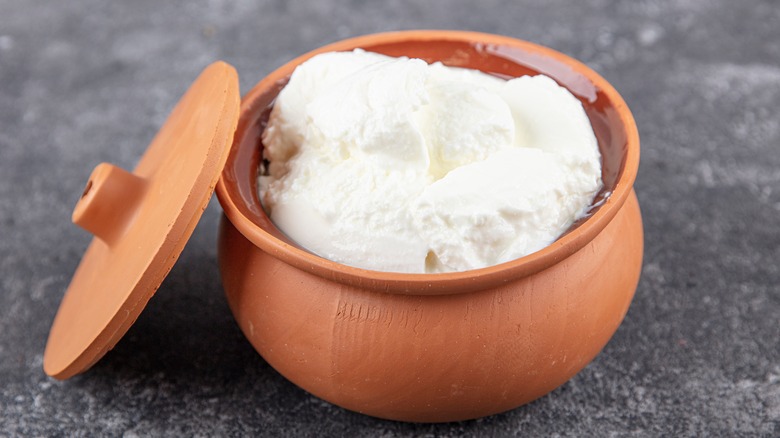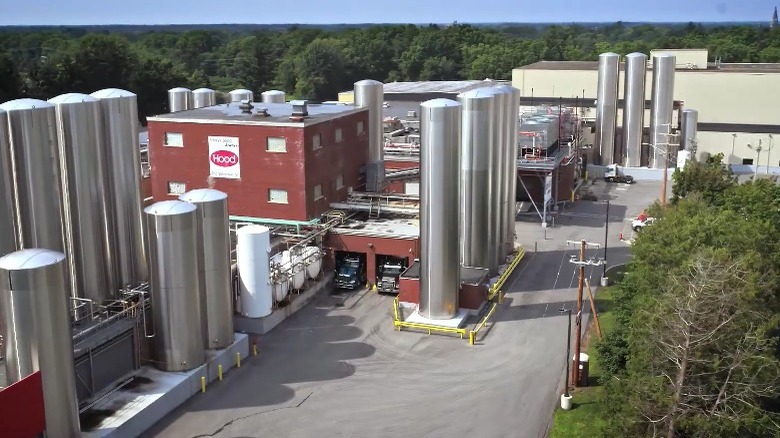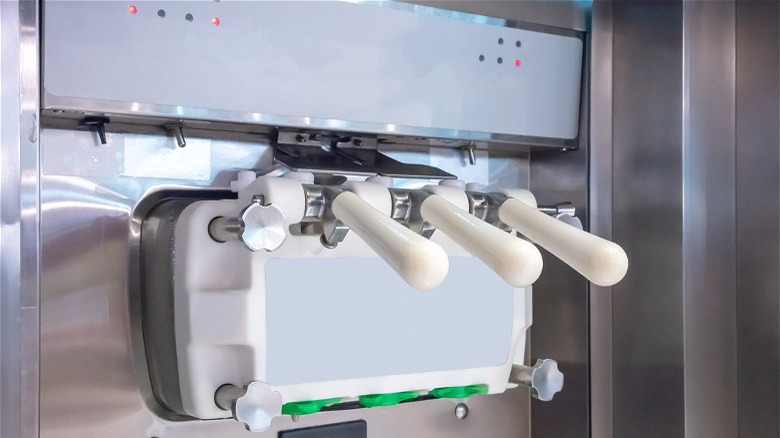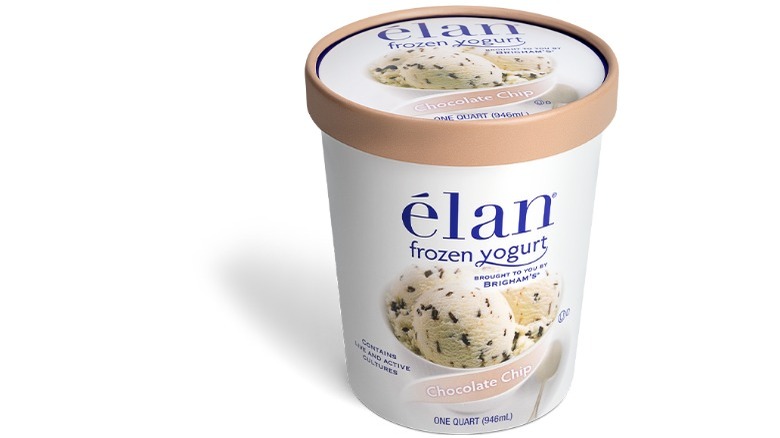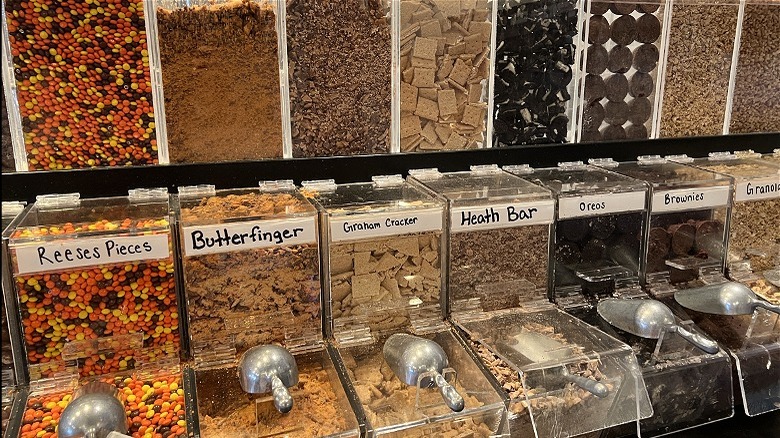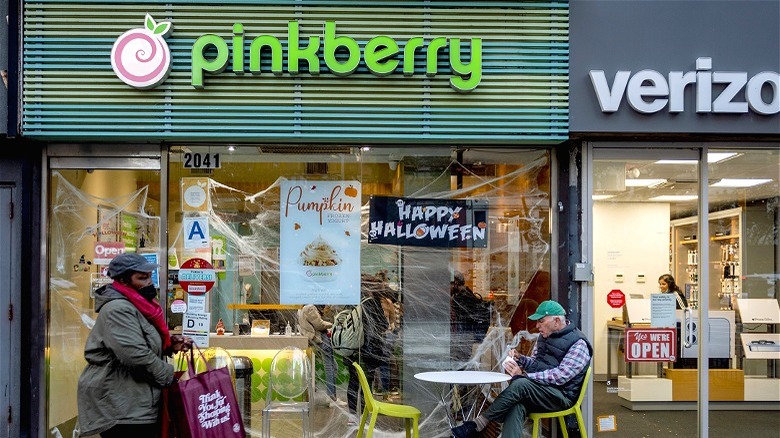The New England Roots Of Frozen Yogurt
Humans have enjoyed frozen sweets for millennia. The most popular of these is arguably ice cream, which was reportedly invented over 2,000 years ago. Although frozen yogurt's history is a much shorter one — starting in New England during the 1970s — its impact on the frozen dessert sector has been immense. Frozen yogurt heralded the arrival of modern, lighter frozen desserts. The food has provided a basis for much further innovation in the dessert sector. What's more, the product has enjoyed periods of immense popularity.
Unfortunately for frozen yogurt and those who make it, the product has never established the enduring popularity of ice cream. Instead, frozen yogurt storms into fashion every decade or so before disappearing. If this pattern continues, we are currently due a frozen yogurt renaissance. While no one knows what form the next wave of frozen yogurt will take, we are sure that it will draw heavily on the product's short but sweet history.
Yogurt itself has been around for much longer
To make frozen yogurt you first need yogurt. Fortunately, the latter predated the former by a few thousand years. As is so often the case with ancient foods, the exact origins of yogurt are not known. One common story is that yogurt was accidentally made by nomadic tribes that left milk in animal skin bottles.
Yogurt's possible discovery was discussed by Elitsa Stoilova, a professor of ethnology, to the BBC: "It's true that yoghurt was part of people's diet for centuries in the Balkan lands. It's a natural process that people discovered somehow... Indeed, the Balkans is one of the many places in the world which has the specific bacteria and temperature ranges needed to naturally produce yoghurt."
Although yogurt had colloquially been known as a healthy food for generations in the Balkans and beyond, it was only in the 20th century that yogurt became scientifically associated with good health. This association massively drove up demand. Consequently, mass production resulted in the manufacturing of less healthy yogurts, thanks to producers adding vast quantities of sugars and sweeteners to their products.
Frozen yogurt was invented in New England
Yogurt is an ancient food. Frozen yogurt, by comparison, is much newer. The story goes that it was invented in Massachusetts during the 1970s. An often-repeated myth is that frozen yogurt was invented by a man called H.P Hood. To make things even more confusing, there were multiple men with those initials associated with the company during this time.
However, Lynne Bohan, the current group vice president of Hood, does not attribute frozen yogurt's invention to H.P. Hood, but rather to the company as a whole. She highlighted this to Dairy Foods: "The company changed its name from HP Hood & Sons to HP Hood Inc. and invented Frogurt, the first frozen yogurt in the U.S. based on a request for a low-fat frozen dessert from Bloomingdale's department stores."
Frozen yogurt did not remain a product unique to Hood or Massachusetts for long. In fact, by the late 1970s, frozen yogurt was being sold by companies in places as far away as Dallas.
Not long after, the first franchise opened in New York
It was not long after frozen yogurt's invention that stores specializing in the product began popping up. The very first frozen yogurt chain was opened in New York City in the late 1970s. Known as Everything Yogurt, the company kickstarted a trend in nationally franchised frozen yogurt shops that first spanned a city and subsequently the nation.
Everything Yogurt chose a good city in which to launch itself. New York has always been especially receptive to frozen yogurt chains over the years. Eric Yun, the United States president of Yogurberry, explained his thinking as to why for The New York Times: "New York has many women, many young people, many Asian-Americans, and many people with a high income. All of those people love frozen yogurt."
Thanks to a strong start, Everything Yogurt went on to have over 200 franchises open in the early 1990s. Despite this previous success — and New Yorkers' apparent predilection for frozen yogurt — the chain only has a few locations left in New York City. It has also become part of the Bananas, Smoothies, and Frozen Yogurt company. Other, once widely popular franchises like Penguin's have suffered a similar fate.
Frozen yogurt chains then sprung up in Massachusetts
Everything Yogurt might have been the first franchise to sell frozen yogurt, but it wasn't the only one. Other companies soon started selling their own versions of the product in the country's metropolitan centers. Demand was especially high in New England, where frozen yogurt was first created. In Boston, this early demand for frozen yogurt was met by a well-loved, local franchise called Brigham's Ice Cream Shop.
Although famed for its namesake product, Brigham's Ice Cream Shop rapidly incorporated frozen yogurt into its business plan. The company even developed and sold the first packaged frozen yogurt. This innovation shaped both the industry and the company itself in years to come by kickstarting the trend of frozen dessert franchises pivoting into retail products.
Brigham's Ice Cream Shop was so committed to frozen yogurt that it bought out Elan Foods, a maker of yogurt desserts, in 1993. Prior to the buy-out Brigham's was already selling 3 million gallons of ice cream and frozen yogurt annually. At its peak, the company would run 100 franchised restaurants mainly situated in New England, New York, New Jersey, Pennsylvania, and Delaware. None of these have survived to the present day although Elan frozen yogurt is still available for purchase in grocery stores.
By the '80s, the treat was popular nationwide
The 1980s marked frozen yogurt's first national boom. A large proportion of this newfound popularity was rooted in the decade's obsession with diet foods. At the time, low-fat diets were all the rage, and frozen yogurt was soon marketed as a lower-fat alternative to ice cream. The cultural acceptance of this marketing ploy was epitomized by Alison Weiss, a woman who was interviewed by The New York Times in 1991: "Eating ice cream has a stigma now, like smoking. If someone comes into the store while I'm waiting for my frozen yogurt and asks for ice cream, I stare at them. There's a whole guilt thing about ice cream ... You know, if you eat yogurt you'll live to be 100. No one ever says that about ice cream."
Increasing demand and availability led to suppliers becoming innovative with frozen yogurt, predominately by creating new flavors. The vast majority of these were dominated by sugar; an ingredient that had not yet been demonized in the same manner as fat. The frozen yogurt chain TCBY led the charge in flavor innovation with options like piña colada and peanut butter. These hugely popular flavors contributed to frozen yogurt's astronomical growth. By the beginning of the 1990s frozen yogurt was making up 10% of the frozen dessert market.
The industry unfortunately waned in the late 1990s
Frozen yogurt franchises like TCBY found immense popularity thanks to the product's low-fat credentials. This, however, was not enough to safeguard frozen yogurt in the long term. Unfortunately, ice cream, in a new, low-fat format, staged its own comeback, taking the wind out of frozen yogurt's sails. What's more, the public demand for healthier foods declined in the mid to late 1990s. Even the biggest franchises in the best markets felt the bite. TCBY had seven locations in Massachusetts in 1990 –at least two of these had closed by 2000.
The challenges faced by frozen yogurt brands were highlighted by TCBY's Vice President of Marketing David Hall to Chain Store Age: "The frozen-yogurt category peaked around the mid-to-late 1990s, and was followed by a trend toward indulgence. Indulgence meant forgetting about healthy nutrition and heading for the most decadent, highest-calorie, highest-fat treat available. As that wave hit, it impacted our business ... We started closing stores. We were in decline."
While national brands were struggling, New England's Hood found a new lease on life. In 1995, the company was bought by the Kaneb family, who set about expanding the company rapidly. This is one of the primary reasons why the New England company is still such a ubiquitous frozen yogurt brand in stores today.
The popularity of frozen yogurt continues to fluctuate
Since the 1970s, frozen yogurt has enjoyed a number of renaissances. Interest in the product soars, before plateauing and subsequently declining. There seems to be a renewed interest in frozen yogurt every ten years or so.
The most recent of these renaissances started in 2005 when Shelly Hwang and Young Lee opened the first Pinkberry store in Los Angeles. Red Mango, a South Korean brand, launched in the U.S. shortly after. Both defined the newest charge of frozen yogurt by implementing tart flavors, and social media-friendly toppings. 16 Handles, another popular brand of this time, championed multi-choice self-service machines.
As happened previously, these once ubiquitous brands suffered immensely as frozen yogurt's popularity waned in the 2010s. At the time of writing, Pinkberry has two locations in Rhode Island, 16 Handles has two in Connecticut, and Red Mango has one in Maine.
By many people's accounts, another frozen yogurt boom is imminent. The form this newly popular frozen yogurt takes is anyone's guess, although vegan frozen yogurt would fit neatly into the current cultural zeitgeist. Yoga-urt, a west coast company, is championing vegan frozen yogurts and is having great success in doing so. This would suggest the next frozen yogurt boom could be on the horizon.

